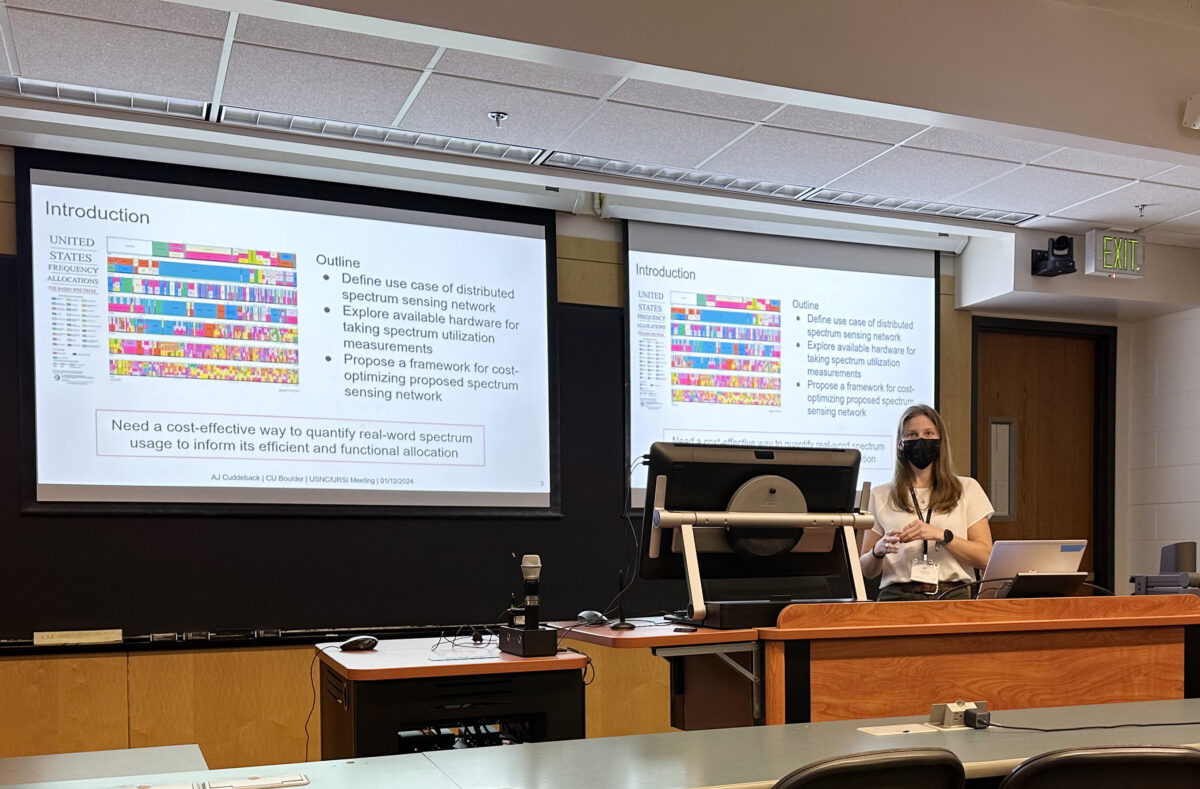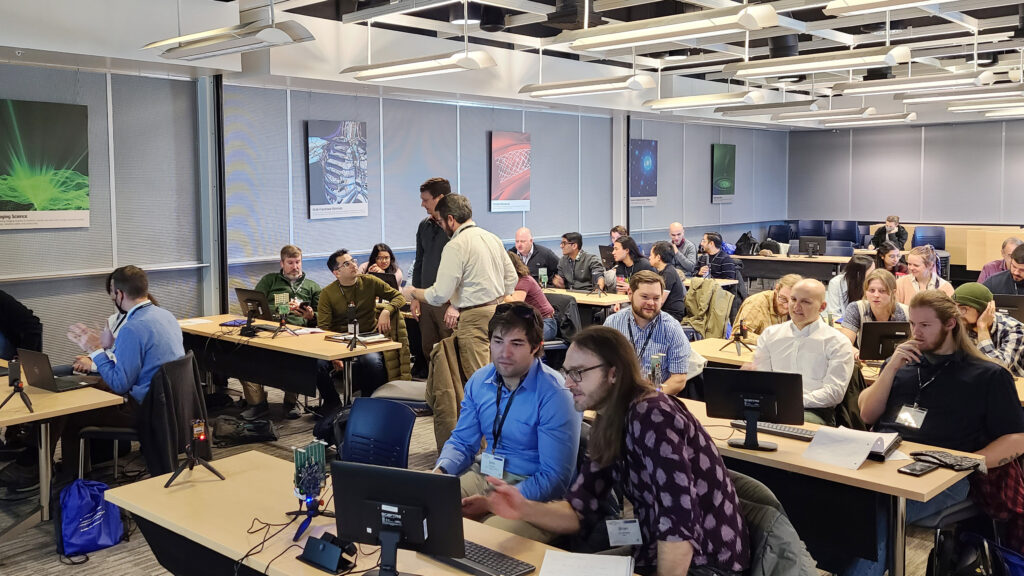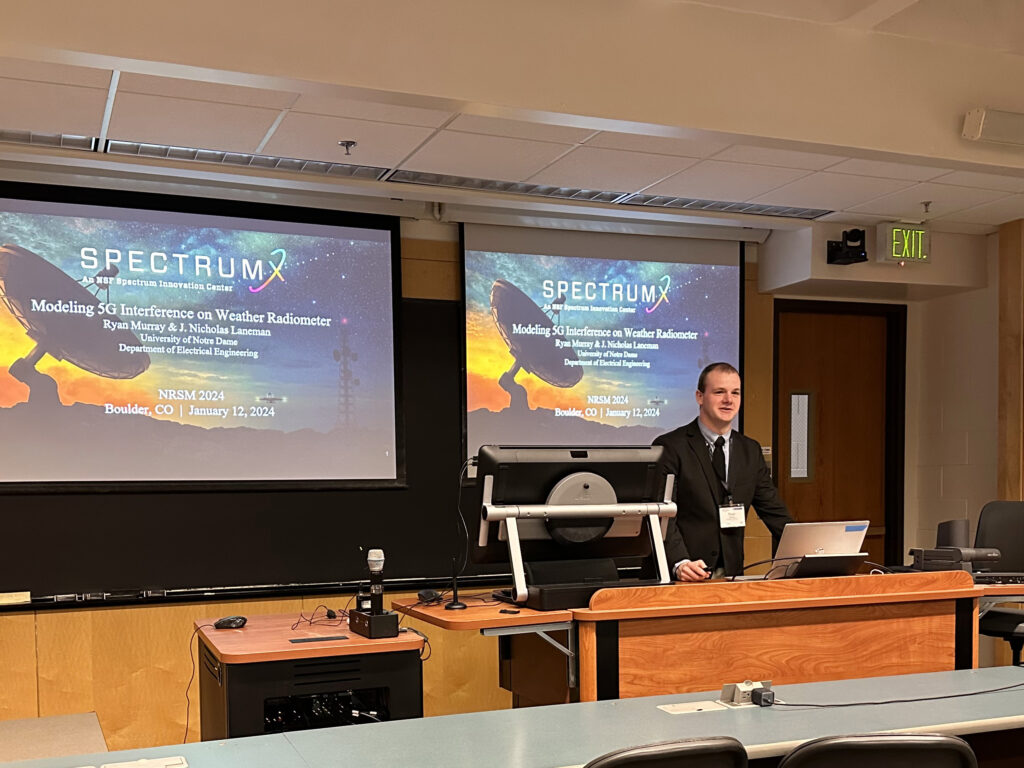NSF SpectrumX members help lead 50th Anniversary USNC-URSI National Radio Science Meeting

By Christina Clark
In January 2024, the National Radio Science Meeting celebrated its 50th anniversary. Twelve members of the SpectrumX, the National Science Foundation Spectrum Innovation Center, including two of the center’s students, were in attendance to further national conversations about radio science, telecommunications and electrical engineering.
The meeting, hosted by the U.S. National Committee (USNC) of the International Union of Radio Science (URSI) and the National Academies of Science, Engineering and Medicine, took place from January 9-12, and resulted in the discussion of 12 research papers co-authored by SpectrumX members.
During the first day of the event, Zoya Popovic, USNC chair of the women in radio science chapter, SpectrumX research partner and distinguished professor, Lockheed Martin Endowed Chair in RF Engineering at the University of Colorado Boulder (CU Boulder), spoke alongside Jonathan D. Chisum, associate professor at Notre Dame. Popovic and Chisum gave a plenary address titled “A History of Technical Contributions.” Chisum and Popovic spoke about the specific contributions of Commission D over the past decade within USNC-URSI, which includes electronics and photonics.
On the same day, Phil Erickson, SpectrumX research partner and director of MIT Haystack Observatory, gave a plenary titled “Progress in Understanding Our Ionosphere, Atmosphere, and Near-Earth Space through URSI Commission G: Selected 50 Year Highlights.” Commission G focuses on ionospheric radio and propagation and includes the communications and sensing of ionized media.
“The history of U.S. Commission G parallels the origins and history of URSI itself, as the earliest 20th century remote sensing tools for the charged upper atmosphere were radio wave based, occurring well before the advent of spacecraft direct sampling of these regions,” Erickson’s abstract said. “We briefly review the 50-year history of Commission G in this light, with its participants and studies driving many significant firsts in global radio science.”

Laila Fighera Marzall, assistant research professor and SpectrumX partner in the University of Colorado Boulder Microwave Group, hosted a workshop with Jon Kraft, Analog Devices, titled “Hands On Phased Array Beamforming (WSI).” The workshop covered phased array beamforming, antenna impairments, monopulse tracking implementation, and jammer mitigation information through a combination of lectures and hands-on labs.
Marzall also chaired a session on Wednesday, January 10, titled “RF Front-ends and Arrays for Simultaneous Transmit and Receive Operation.” Within this session, Paige Danielson, graduate student at CU Boulder, presented work on a SpectrumX project titled “Broadband GaN MMICs for Analog Interference Suppression.” Danielson’s presentation was co-authored by Popovic.
Marzall and Popovic presented a co-authored paper titled “40-44GHz MMIC Frequency Tunable Butler Matrix.”
For Ryan Murray, an undergraduate student studying electrical engineering at the University of Notre Dame, the meeting exposed him to the work and research going on in radio science. Murray also presented his research, guided by SpectrumX center director and professor of electrical engineering at the University of Notre Dame, Nick Laneman.

“I was introduced to so many ideas and it was a memorable experience,” said Murray. “I am glad that I had the opportunity to show my work in this environment and receive helpful feedback that will continue to shape my work moving forward.”
Throughout the meeting, researchers and experts presented their findings through 12 research papers including:
- Scott Palo, NSF SpectrumX associate director, Victor Charles Schelke Endowed professor, University of Colorado Boulder, is listed among co-authors of “Meteor Radar Phased Interferometry Calibration with Aircraft Observations and ADS-B Integration”
- Taylor Barton, NSF SpectrumX research partner, associate professor, Lockheed Martin Junior Faculty Fellow at the University of Colorado Boulder, is listed among co-authors on “Superconducting Kinetic Inductance-Based On-Chip Frequency Conversion.”
- Popovic was listed as a co-author of “In-Band Bull-Duplex Array Architectures and Performance Survey ”and “Broadband GaN MMICs for Analog Interference Suppression,” along with Paige Danielson, graduate student at CU Boulder.
- Popovic and Marzall co-authored “40-44GHz MMIC Frequency Tunable Butler Matrix.”
- Albin Gasiewski, NSF SpectrumX research partner and professor at the University of Colorado Boulder, was listed as a co-author of “An In-Situ Measurement System Using Downconversion.”
- AJ Cuddeback, NSF SpectrumX student and Ph.D. student at the University of Colorado Boulder, Palo, and Erickson co-authored “An Analysis of Low-Cost SDRs to Meet City-Wide Spectrum Utilization Measurement Requirements.”
- Ryan Murray, undergraduate electrical engineering student at the University of Notre Dame, and J. Nicholas Laneman, NSF SpectrumX center director and professor at the University of Notre Dame, co-authored “Modeling 5G Interference on a Weather Radiometer.”
- Bertrand Hochwald, NSF SpectrumX project team lead and Freimann professor of electrical engineering at the University of Notre Dame, and Laneman, were listed as co-authors of “Digitally-modulated OOK Reconfigurable Intelligent Surfaces for Massive-scalable Gbps Transmitters.”
The full program and list of papers can be found at: National Radio Science Meeting 2024.
About SpectrumX
SpectrumX is funded by the U.S. National Science Foundation (NSF) as part of its Spectrum Innovation Initiative, under grant number AST 21-32700. SpectrumX is the world’s largest academic hub where all radio spectrum stakeholders can innovate, collaborate, and contribute to maximizing social welfare of this precious resource.
To learn more about SpectrumX, please visit spectrumx.org.
Contact:
Christina Clark, Research Communications Specialist
SpectrumX / Notre Dame Research / University of Notre Dame
cclark26@nd.edu / 574.631.2665
spectrumx.org